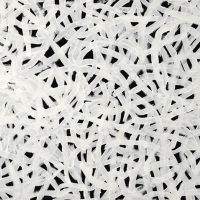118. EMILY KAME KNGWARREYE

The celebrated Japanese ukiyo-e printmaker, Katsushika Hokusai (1760-1849), described himself as an old man mad about drawing.1 Hokusais working life spanned seven decades. At the age of seventy, the artist embarked upon his magnum opus, the Thirty-six Views of Mount Fuji, which included The Great Wave off Kanagawa, undoubtedly the most famous image in Japanese art. Hokusai worked up to his death at the age of 87, declaring on his deathbed: If only Heaven will give me just another ten years ... Just another five more years, then I could become a real painter.2
Like Hokusai, Emily Kame Kngwarreyes creativity blossomed well into old age. Born in 1910, Emily would not create her first major works on canvas until the summer of 1988-89, as she neared the end of her eighth decade.3 The artists late works reveal no signs of creative fatigue: on the contrary, those dating from her final year of 1996 - such as the present work, Yam Dreaming - are among Emilys most highly prized creations.
Emily was born into the Anmatyerre community in country known as Alhalkare, approximately 250 kilometres north east of Alice Springs. In 1926, the Anmatyerre tribal lands were incorporated into the Utopia pastoral lease, and Emily was employed on several properties as a housekeeper and farmhand.4 Between 1977 and 1988, Emily and other Utopia artists began to experiment with hand-dyed fabrics using a process akin to traditional Javanese batik.5 Emilys early designs employed an intense visual language of dots and lines that would subsequently inform her paintings on canvas.
From the outset, Emilys art has been concerned with womens business, chiefly that relating to the harvesting of yams native to the Alhalkare area (Vigna lanceolata). Emily occupied a senior position within her community as the boss woman responsible for maintaining Awelye (womens ceremonies) for this yam.6 This status is reflected in Emilys full name: Kame literally translates to seed. In wet conditions, the yams grow vigorously within the sandy desert soil, providing a dietary staple for the Anmatyerre people. At the end of the growing season, the tubers wither and die, rendering a crazed pattern in the topsoil above.7
This natural process likely formed the inspiration for Yam Dreaming and other works from 1995-96, which feature dense morasses of interwoven lines extending to the very edges of the canvas. Emilys restrained black and white palette lends these paintings a stark, graphic quality which is offset by the rhythmic fluidity of her brushwork. The present work shows many points of resemblance with Anwerlarr Anganenty (Big Yam Dreaming) 1995, Emilys monumental line painting in the collection of the National Gallery of Victoria. As curator Judith Ryan observes,
The drawn surface lays bare the skeleton, the bones, which structure much of her art. The rhythmical monochrome design can also be likened to the veins, sinews and contours seen in the body of land from above. Big Yam Dreaming stands as Kngwarreyes greatest graphic statement, against which her colourist works float and have their anchor.8
In the years following her death, Emilys works have continued to garner further acclaim. In 1997, the artist posthumously represented Australia at the Venice Biennale, and in 1998 the Queensland Art Gallery curated a major touring retrospective.9 In 2008 the National Museum of Australia collaborated with a number of museums in Japan to present a major survey exhibition of Emilys work, Utopia: the Genius of Emily Kame Kngwarreye.10 Had Emilys life been only a decade shorter, her remarkable sensibility for colour and line might never have been truly realised.
Footnotes
1. Exhibition: Hokusai, National Gallery of Victoria, Melbourne, 2017, accessed online: https://www.ngv.vic.gov.au/exhibition/hokusai/
2. Ibid.
3. Ryan, J., Kwementyay Kngwarreyes Big Yam Dreaming, Art Journal, National Gallery of Victoria, Melbourne, 1997, vol.37, accessed online: https://www.ngv.vic.gov.au/essay/kwementyay-kngwarreyes-big-yam-dreaming-2/
4. Isaacs, J., Spirit Country: Contemporary Australian Art, Hardie Grant Books, Melbourne, 1999, p.102
5. Ibid., p.102
6. Ibid., p.102
7. Ibid., p.104
8. Ryan, J., Kwementyay Kngwarreyes Big Yam Dreaming,
9. Isaacs, J., Spirit Country: Contemporary Australian Art, p.104
10. Utopia: the Genius of Emily Kame Kngwarreye, National Museum of Australia, Canberra, 2008, accessed online: http://www.nma.gov.au/exhibitions/utopia_the_genius_of_emily_kame_kngwarreye/home
Catherine Baxendale B. Phil (Hons), MA (Art Curatorship)